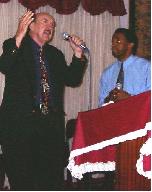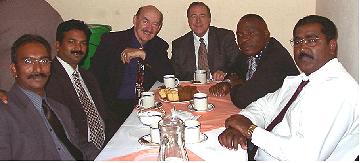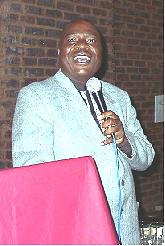The San (Bushmen) are among the oldest indigenous peoples of South Africa. In
1488, a Portuguese navigator became the first European to round the Cape of Good
Hope.
Although European vessels frequently passed by South Africa on their way
to E Africa and India, and sometimes stopped for provisions or rest, no
permanent European settlement was made until 1652, when Jan van Riebeeck and
about 90 other persons set up a provisioning station for the Dutch East India
Company at Table Bay on the Cape of Good Hope.
By 1662, about 250 Europeans were
living near the Cape and gradually they moved inland. In 1689 about 200 Huguenot
refugees, (escaping religious persecution) from Europe arrived. By 1707 there
were about 1,780 freeholders of European descent in South Africa, and they owned
about 1,100 s1aves.
During the French Revolutionary
and Napoleonic wars, the British replaced the Dutch at the Cape from 1795 to
1803 and again from 1806 to 1814. In 1833 slavery was abolished in the British
Empire, an act that angered South African slaves owners.
To escape the restrictions of
British rule as well as to obtain new land, about 12,000 Boers left the Cape
between 1835 and 1843 in what is known as the Great Trek. Some remained in the
higbveld of the interior, forming isolated communities and small states. A large
group traveled eastward into what became Natal. The first indentured laborers
from India arrived in Natal to work on the sugar plantations, and by 1900 they
outnumbered the whites there. Diamonds were discovered in 1867 and in 1870 at
what be-came Kimberley; in 1886 gold was discovered.
These discoveries (especially
that of gold) spurred great economic development in S Africa during 1870-1900;
foreign trade increased dramatically, rail expanded from 70 mi (110 km) in 1870
to 3,600 mi (5,790 km) in 1895, and the number of whites rose from about 300,000
in 1870 to about 1 million in 1900. In 1961, South Africa left the Commonwealth
of Nations and became a republic. In 1984, a new constitution was made. The new
Parliament included the House of Representatives, comprised of Coloreds; the
House of Delegates, comprised of Indians; and the House of Assembly, comprised
of whites.
This system left the whites with
more seats in the Parliament than the Indians and Coloreds combined. Blacks
violently protested being shut out of the system. In 1989, President Botha fell
ill and was succeeded, first as party leader, then as president, by F. W. de
Klerk. De Klerk's government began relaxing apartheid restrictions and in 1990,
Nelson Mandela was freed after 27 years of imprisonment and became the lead of
the recently legalized ANC. Despite obstacles and delays, an interim
constitution was completed in 1993, ending nearly three centuries of white rule
in South Africa and marking the end of white-minority rule on the African
continent.
In April 1994, the first
multiracial election was held. The ANC won an overwhelming victory. and Nelson
Mandela became president. In 1994 and 1995 the last vestiges of apartheid were
dismantled and a new national constitution was approved and adopted in May 1996.
The population of South Africa is 75% black (African) and 13% white (European),
with about 9% people of mixed white, Malay, and black descent (formerly called
"Colored"). and 3% of Asian (mostly Indian) background. South Africa has 11
official languages, nine of which are indigenous: Zulu, Xhosa, Tswana Sotho,
Swazi, Venda, Ndebele, Pedi, and Tsonga. Many blacks also speak Afrikaans (the
first language of about 60% of the whites and the majority of those of mixed
race) or English (the first language of most of the rest of the nonblacks. 68%
of the population is Christian, major groups include the Dutch Reformed,
Anglican, Methodist, Roman Catholic, and Zionist churches.
Over 28% of the population
follows traditional African religions, and there are small minorities of
Muslims, Hindus and Jews. Republic of South Africa, republic (1995 est. POP
45,095,000), and the land size 471,442 sq mil (1,221,037 sq km), S Africa. It
borders on the Atlantic Ocean in the west, on Narnibia in the northwest, on
Botswana and Zimbabwe in the north, on Mozambique and Swaziland in the
northeast, and on the Indian Ocean in the east and 5outh. The largest city is
Johannesburg.
Cape Town is the legislative
capital, Pretoria the administrative capital, and Bloeinfontein the judicial
capital. Until about 1870 the economy of the region was almost entirely based on
agriculture. With the discovery of diamonds and gold in the late 19th century
mining became the foundation for rapid economic development. Whites largely
control the economy, but nonwhites make up more than 75% of the workforce. South
Africa is a world leader in the production of gold, diamonds, alumi nosilicates,
chromium, manganese. vanadium. and platinum. Other leading minerals extracted
are copper ore, coal, asbestos, iron ore, silver, and titanium. Uranium is also
whole life mined.
THE RICHES ARE THE PEOPLE OF
AFRICA!
Home
|
The Good News
|
Tony's Sermons
|
Some Thoughts
|
The Team
|
About Us
|
Support Us
|
Contact Us
Web Pages and HTML Sources are
ęCopyright 2002-2025 |
Web Development: Digital Smiles






